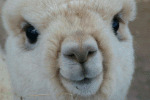Articles by Alpaca World Magazine:
THE UK LEADS THE WORLD IN ALPACA ORTHOPAEDICS
John Potts
In February of this year The Alpaca Stud imported a number of high quality stud males from Canada. All went well for the first few weeks and everyone was excited about the new arrivals.
And then tragedy struck. One of the most highly rated males was found dead one morning having been well and in good condition the day before. The cause: a urinary blockage-possibly a kidney stone. About a week later just after the depression was lifting another of the males was found to be lame in its right hind leg. Examination suggested a cruciate ligament problem, which was subsequently confirmed by the vet to be correct. The alpaca was in a lot of pain, could not use the leg and it was getting worse. The usual course of action is to euthanase the animal quickly; a cruciate ligament has never been repaired on a horse, only once in the US with limited success and only recently is starting to be carried out by specialist orthopaedic consultants on dogs.
We could not face up to another loss so we took the alpaca (Quento) to see a veterinary orthopaedic consultant called Noel Fitzpatrick. If you have never met anyone with a genuine triple A character who runs everywhere and frequently operates for 22 hours a day (no exaggeration) go and see Noel. He had never attempted such an operation before although proficient at carrying out similar procedures on dogs. Noel quickly researched the world veterinary reports and announced he was prepared to carry out the operation with a reasonable prognosis but, of course, no guarantees. We approached the insurers to see if they would help with the £3000 + bill offering to agree a reduced death benefit in return. They declined but we decided to continue. (In fact the insurers kindly volunteered 50% of the bill later without any effect on the sum insured.).
A couple of days later we arrived for the operation. Two vets from Newmarket arrived who were specialist anaesthetists. Nick Harrington Smith and I held Quento whilst he was anaesthetised. Eventually he agreed to lie down, was lifted on to a stretcher and carried into the operating theatre. Swallowing hard, for this had been one very brave boy, Nick and I left, both believing that we would probably not see him again as we had agreed that if on examination it appeared to Noel to be hopeless, we would not wake him up.
The hours crawled by until finally the ‘phone rang at 11.30. The operation had been a success so far but now came the difficult period of gentle restraint and full recuperation. Quento returned resting on me in the back of the trailer. Illegal? Who cares! He moved into a small pen in the garden under a sunshade where he was plied with drugs orally and by i/v for a couple of weeks. A small hiccough arrived after a few days when the theatre swab results were returned showing the presence of a serious bacteria which could prove fatal if it took a hold. Massive doses of a new American antibiotic were added to the daily drugs. Regular visits to the surgery confirmed that he was doing well and after four weeks he started to use the leg. The day of judgement came after six weeks when Quento returned for a full examination including being filmed and photographed parading up and down outside the surgery. He played the part to the full before leading Nick up the steps to the waiting room, past bemused clients of the practice, along corridors, before barging through double doors and presenting himself in the X-Ray room. With no anaesthetic or any other medication he allowed himself to be lifted on to the table and for photographs to be taken with Noel, Nick and I holding him. He then got up and marched back into the trailer.
The X-Rays? A stunning success with perfect alignment. The prognosis? Two more weeks of pen dwelling and then back to his mates to relay his experiences. We expect him to be working later this year.
A first for the UK, well done to Noel and his team. The anaesthesia process will shortly be appearing in a veterinary journal and the operation itself will follow later this year. However for those of you who are technically minded, here is a layman’s view of what went on.
The Cranial Cruciate Ligament (known as the Anterior Cruciate Ligament or ACL in humans) is a band of tough tissue in the centre of the stifle (knee joint) that stops the tibia (shin bone) from moving forwards relative to the femur (shinbone). If it becomes torn or ruptures, the stifle becomes unstable resulting in pain, swelling, cartilage damage and arthritis. (See Diag 1)
The anatomical structure in this area is not totally dissimilar to humans where the ligament usually ruptures due to excessive forces such as twisting or jumping, and is often seen in footballers and golfers. I believe Noel may put it, in his inimitable way: it is a common design fault where he has been able to improve on God’s little error! Current thinking is that apart from trauma a number of other factors may be involved, including:
Hormonal factors
Shape of the knee joint
Angle of the tibial plateau (the top of the shin bone)
Body weight
In dogs the ligament may stretch gradually and/or tear a little at a time before rupturing completely. We have no evidence of this being the case in alpacas but it would appear logical.
The procedure carried out by Fitzpatrick Referrals is known as a Tibial Plateau Levelling Osteotomy (TPLO). It is thought that the top of the tibia in camelids, known as the Tibial Plateau is angled backwards, as in dogs. This means that the femur tries to slide backwards when the alpaca stands on the leg, and is restrained by the Cranial Cruciate Ligament. This puts repeated stress on the ligament and is a major factor in causing the ligament to rupture. (Diag 2)
Most veterinarians treating dogs have aimed to rebuild or replace the ruptured ligament. However, it is now known that because the mechanical problem described above is still present, replacement ligaments will almost always break or stretch as time goes on, and that arthritis will continue to develop. TPLO does not aim to rebuild or replace the ligament. Instead it aims to change the angle of the tibial plateau, so that when the alpaca puts weight on the leg, the Cranial Cruciate ligament is no longer needed to stabilise the joint. This is done by cutting the bone (“Osteotomy”) of the tibia and rotating the top section into a more appropriate position. (Diag 3)
OBSERVABLE SYMPTOMS
When Quento went lame it was possible to observe stifle laxity and significant stifle effusion, particularly medial pouching of the synovium caudel to the straight patellar tendon (i.e. swollen hock!) Radiography confirmed this evidenced as opacification encroachment of the infrapatellar fat pad and caudal bulging of the subgastrocnemius fat plane.
Where an alpaca is different to a dog is that there is no fabellae or fibula and so when the Cranial Cruciate Ligament injury is diagnosed tibial plateau levelling osteotomy is the preferable route to follow. Bearing in mind the expectation of high ”athletic” and functional activity of a alpaca stud male the objective of tibia plateau levelling osteotomy is to neutralise tibial thrust by rendering the tibial plateau perpendicular to the straight patellar tendon. In Quento’s case the preoperative tibial plateau angle was 17 degrees and the postoperative angle 3 degrees.
PROCEDURE
A tibial plateau levelling osteotomy was performed by means of the well known Slocum technique using a 30mm biradial saw blade to perform osteotomy of the proximal tibia, whereupon the proximal segment was rotated 6.25mm and anchored using a precontoured 3.5mm broad stainless steel Orthomed plate and screws. The bone was fixed rigidly in place. The remnants of the Cranial Cruciate Ligament were debrided. Postoperatively meloxicam and clavulanate-potentiated amoxicillin were administered in the short term together with an intravenous antibacterial with Augmentin TM for the first 48 hours. The bone will heal over about 12 weeks but the plate remains in place unless it causes a problem. (Photos 4 & 5)
IMPROVEMENTS IN THE NEW PROCEDURE
Improvements have been made to the US procedure:
-The incision used was further forward and the proximal segment slightly larger following the teaching Kowaleski at Ohio University. This enables greater certainty in ensuring that the bone join is at the epicentre.
-The new Orthomed plate used is larger than the old Slocum plates (and there is some concern that the older plates may have leached chemicals into the blood stream).
-This technique ensures better collateral ligament stability and better rotation.
-Ensuring that the stifle joint is exact without any opposition of the edges nearly halves recuperation time to full mobility.
-The screw placement has been changed and improved to ensure they are well away from the joint.
-The alignment of the axial plane has been improved, achieved by ensuring that on alignment the calculus bisects the patella.
My thanks for this information co to Fitzpatrick Referrals and even greater thanks for restoring Quento to good health.
Tweet



